
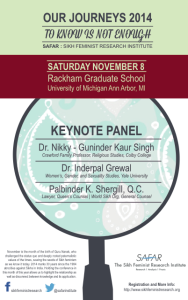 Guest post by Sarina Kaur
Guest post by Sarina Kaur
“A Sikh’s entire life is life of benevolent exertion”. Sikh Rehat Maryada (Code of Conduct)
Benevolent exertion. These powerful words along with countless examples from history, gurbani, and rehat remind us that to question, challenge, and think for the purpose of informing our actions according to the Guru’s teachings is a Sikh’s birthright, privilege, and responsibility. This benevolent exertion toward an egalitarian world and empowered society devoid of oppression is a standard rooted in our collective psyche. But to know this, is not enough. The first Sikh Feminist Conference in North America, by SAFAR: the Sikh Feminist Research Institute, seeks to unpack what this means for Sikhs of the 21st century.
Personally, at every turn in my own journey toward creating a life imbibed with thoughtful action toward a more just and humane world, I have craved to understand and experience the unspoken viewpoints of the Kaur experience. Today, few can deny that no matter where you look- within the Sikh social context or in the global context-the dominant narrative is not inclusive of the female voice; that our calibrated center-where we collide as a society-is not in line with the standards our Guru’s introduced. A space for expansive revival, attention, voice and praxis to the feminist values and egalitarian politics inherent within Sikhi is a step toward a more calibrated center.[1] SAFAR’s Conference Program promises such progressive steps.
Distinguished keynote panelists, Dr. Nikky-Gurinder Kaur Singh, Dr. Inderpal Grewal, and Palbinder K. Shergill will launch the discussions and introspections for the day while exploring the topic “What Do We Know?” By exploring what knowledge exists from various sources, this panel promises to dive into an exploration of the intersectionality of Sikhi, feminism and discourse on Sikh Feminism. Each of the panelists is a pioneer in her own right; while Dr. Singh is often fondly thought of as the mother of ‘Sikh feminism’, Dr. Grewal from Yale is lauded for her seminal work on ‘transnational feminism,’ while Ms. Shergill is a trailblazer in the courtrooms in Canada, and just recently distinguished herself as the only female lawyer in the Supreme Court, that too while articulating the fundamentals of religious freedom in a case about the religious freedoms for a non-Sikh-Sikhi in action! I look forward to their discourse and interaction with each other as moderated by writer and activist, Inni Kaur.
Op-Ed printed in The Harlem Times Nov/Dec Issue
White supremacy typically evokes images of Klansmen on night rides setting homes ablaze with burning crosses or white policemen hosing down African American protesters during the civil rights movement. However, white supremacy is also what led a group of black teenagers to violently attack a Sikh man in Harlem this September. Given that the attackers are not white, how then is white supremacy related?
Early reports indicated that a group of 15-20 young boys assaulted Dr. Prabhjot Singh yelling “Terrorist†and “Get Osama,†leaving him with several injuries including a fractured jaw. What Dr. Singh experienced is not an isolated incident. Though violence against Sikhs has increased in the last 10 years and some attribute this to 9/11, it is part of a much more complex narrative that pre-dates 9/11: long-standing histories of oppression and genocide of Sikhs in pre-colonial and post-colonial India as well as systemic racism in the U.S. Media reports of the attack against Dr. Singh have followed an almost prosaic plot, identifying post 9/11 backlash, Islamophobia, racial profiling and misidentification as the usual suspects but failing to address white supremacy as a root cause in both the past and present.
Though police have not yet identified the attackers, accounts from Dr. Singh and eyewitnesses intimate that his aggressors were young black boys. When Melissa Harris-Perry interviewed Dr. Singh, she remarked on her surprise that his assailants represent a group also targeted by racism. However, it is precisely their experience as targets of racism which likely motivated them. Black males continue to be targeted and profiled as dangerous or unsafe or less competent at work and school, as evidenced recently by the NYPD’s use of stop and frisk tactics and the murder of Trayvon Martin. Historically, groups systematically targeted by racism scapegoat other groups that pose real or perceived threats. During the founding years of the United States, divisions between communities began when slavery and colonialism were the reality of white on black relations. Tensions between people of South Asian and African heritage have an equally long history, spanning the 19th century when Indians first immigrated to Africa and the U.S. Lastly, race still defines our society, the way we see ourselves and other groups of people as it has for centuries though now in a more diverse context.
In many ways, what Dr. Singh experienced was similar to the way Irish, Jewish and Japanese immigrants were scapegoated in the 19th and 20th centuries in the U.S. (more…)
University of Massachusetts – Boston
Department of Counseling and School Psychology
100 Morrissey Blvd, Boston, MA 02125-3393
University of Massachusetts Boston
Researcher: Dr. Kiran S. K. Arora
Study: Religious Discrimination and Race-Related Stress among North American Sikhs.
We are interested in conducting research with Sikhs living in North America. The purpose of the study is to examine how experiences of religious discrimination and race-related stress may impact the relationships, mental health, and overall well-being of Sikhs. To gather this information, we are looking for individuals over the age of 18, who self-identify as Sikh, and are living in North America, to complete a set of anonymous questionnaires online.
This study hopes to contribute to a dearth of academic literature on Sikhs and their families. Your contribution is valuable, as it would provide insight for family therapists and other mental health professionals working with Sikh families. Your participation is strictly voluntary. Confidentiality is of utmost importance, and measures will be taken to protect your identity.
The purpose of this announcement is to alert you to the research project and invite you to ask any questions you may have about this project. You may contact Dr. Kiran S. K. Arora at Kiran.Arora@umb.edu if you are interested in participating, or learning more about the study. To learn more about the study or participate, you may also go to https://www.psychdata.com/s.asp?SID=153728.
Two of my fellow Sidakers from the class of 2012 have written wonderful blog posts that are succinct and tell you concisely what their Sidak experience was like. Please do give them a read: Santbir Singh on Sikhchic “Why I’ll Be There.” and Ruby Kaur on Sikhnet with the aptly titled, “Amazing Sidak.” It should come as no surprise that my post about my experience is long, but I’ve inserted photos to hide this fact.
Last July was a busy one for me. I attended a playwriting workshop in Cape Cod, and directly after that, it was off to Texas for two weeks of Sidak, an experience I still find difficult to put into words. It is officially:
“a distinctive leadership development program for young adults seeking to increase their commitment towards the Sikh faith. This two-week intensive immersion in Sikh culture, language, values and community though understanding bÄnÄ« (scripture), tvÄrÄ«kh (history), and rahit (discipline), is held annually in the Hill Country of San Antonio, Texas.â€
There is nothing I disagree with in their description, but to me it is much more than just those things. I first learned about Sidak from a blog post on TLH by Sharandeep Singh, and I was very enticed by the Gurmukhi course. So enticed, I applied, despite my initial reservations. Those reservations were primarily based on the fact that I didn’t fit into the perceived demographic I had pinged in my head as the sort of person who would attend Sidak. I’m not a Sikh active in my community (at least not in the conventional sense), the gurduara, or even someone who had grown up attending Sikh youth camps, except one year at Jakara when I was 30 (http://ow.ly/l2F6X). I’m in my mid-30s, occasionally go to the gurduara, and while I read, write, and speak Punjabi “relatively well,†I am not well versed in Sikh theological terminology. I had no idea what the difference between a tuk, a var, or a bani were, when they’d be used in class or during Divan.
Guest blogged: Mewa Singh
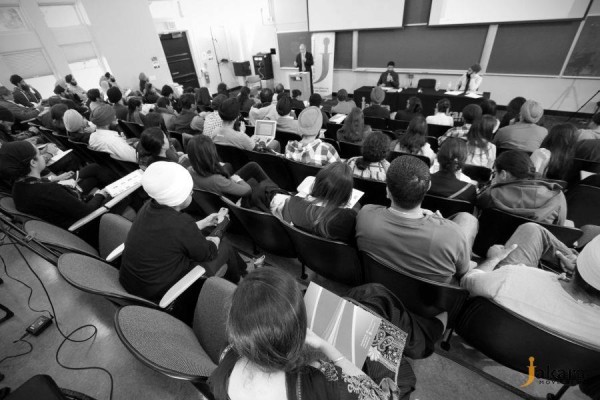 From February 16-17, 2013, researchers from throughout the world, focusing on Sikh-related topics, came together at Stanford University for the 4th annual Sikholars Conference, hosted by the Jakara Movement. From Europe to Pakistan, from India to Canada, and throughout the United States, young scholars came together for a weekend of discussion and engagement in a unique forum that connects the academy to the community. Here, I provide here a bit of a recap and encouragement for those that missed this year to make sure you don’t miss Sikholars 2014.
From February 16-17, 2013, researchers from throughout the world, focusing on Sikh-related topics, came together at Stanford University for the 4th annual Sikholars Conference, hosted by the Jakara Movement. From Europe to Pakistan, from India to Canada, and throughout the United States, young scholars came together for a weekend of discussion and engagement in a unique forum that connects the academy to the community. Here, I provide here a bit of a recap and encouragement for those that missed this year to make sure you don’t miss Sikholars 2014.
The conference commenced with an opening address by Professor Thomas Blom Hansen. The director of Stanford University’s Center for South Asia welcomed the audience and shared his excitement for a new partnership between the Jakara Movement and the Center for South Asia in years to come in hosting the Sikholars Conference.  Next followed a lecture by Professor Linda Hess, one of the world’s foremost authorities on Bhagat Kabir Ji.
Guestblogged by Mewa Singh
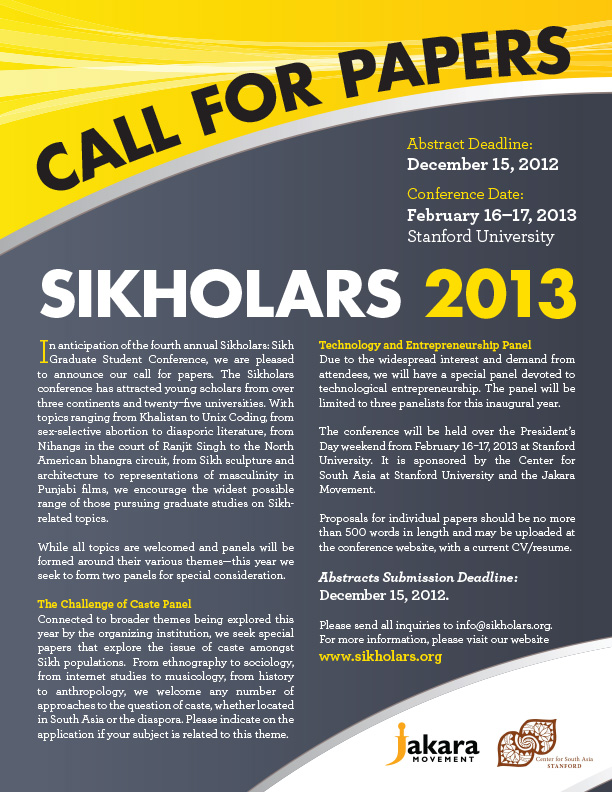 Few events are as anticipated as the annual Sikholars conference, held annually in the Bay Area. Now returning for the fourth year, the event continues to grow, generate new interest, and excite Sikh sangats from the Bay Area and beyond. A showcase for young Sikh scholars and others working on Sikh-related topics, the venue provides an intellectual space for engagement, discussion, and debate.
Few events are as anticipated as the annual Sikholars conference, held annually in the Bay Area. Now returning for the fourth year, the event continues to grow, generate new interest, and excite Sikh sangats from the Bay Area and beyond. A showcase for young Sikh scholars and others working on Sikh-related topics, the venue provides an intellectual space for engagement, discussion, and debate.
The conference has already announced its “call for papers”:
In anticipation of the fourth annual Sikholars: Sikh Graduate Student Conference, we are pleased to announce our call for papers. The Sikholars conference has attracted young scholars from over three continents and twenty–five universities. With topics ranging from Khalistan to Unix Coding, from sex-selective abortion to diasporic literature, from Nihangs in the court of Ranjit Singh to the North American bhangra circuit, from Sikh sculpture and architecture to representations of masculinity in Punjabi films, we encourage the widest possible range of those pursuing graduate studies on Sikh-related topics.
The deadline to apply to present is December 15, 2012.
The event is being hosted by Stanford University’s Center for South Asia and the Jakara Movement.
Guestblogged by Mewa Singh
Applications are out and will soon be due. Need some assistance? Then here is a service for you!
Here are the Top 5 Reasons You should Use the Jakara Movement’s Sikhiya Service:
- Save money – there are a number of professional services on the market that provide personal statement assistance and help. Websites like accepted.com charge in the thousands of dollars for this type of service. You’re getting it for free!
- Expert Help – Get help from other Sikhs that have successfully already gone through the process. They will edit your writing and share admission tips.
- Fast Turnaround – Most drafts are sent back within 48 hours. Can’t get much faster than that!
- Confidential – Confidentiality is completely respected. After you upload your draft, your name and other personal information is removed before being sent to the editors. All editors also sign confidentiality notes to respect the privacy of you and your writing.
- Pay It Forward – The idea of this type of seva works through the principle of ‘pay it forward.’ Just as you will be using the service today, the hope is that you will provide this service for another young Sikh in the future.
A number of Sikhs have already taken advantage of the Sikhiya program, part of Jakara Movement’s Sikholars initiative.
This weekend, from Friday to Sunday October 19-21st, the Sikh Studies department at Hofstra University will host ‘Sikhi(sm), Literature and Film,’ a conference on literary and visual cultures in the Sikh tradition, both in Panjab and the Diaspora.
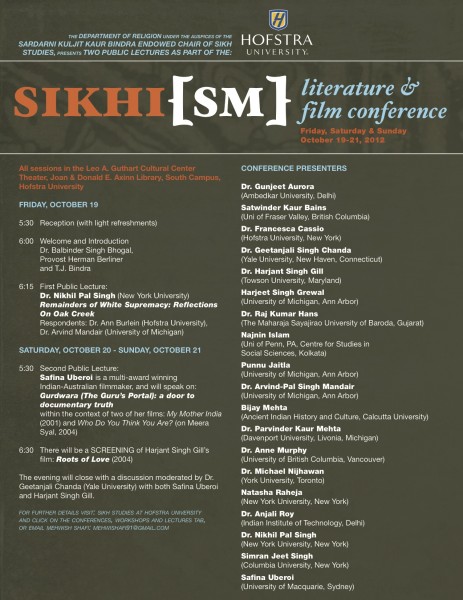 Paper presentations will be given during five sessions, with presentations ranging from de-categorizing the janamsakhis to the poetry of Puran Singh, discourses on secularism to literary representations of Sikhs, Sikh masculine identity vis-à-vis kesh and the dastaar to Panjabi theater, Museum exhibitions to Sikh identity in film and Bollywood, Hip Hop and rap as expressive forms among Panjabi youth to Gurbani sangeet and female kirtaniya. Presentation topics and bios can be accessed via the Sikh Studies website at Hofstra.
Paper presentations will be given during five sessions, with presentations ranging from de-categorizing the janamsakhis to the poetry of Puran Singh, discourses on secularism to literary representations of Sikhs, Sikh masculine identity vis-à-vis kesh and the dastaar to Panjabi theater, Museum exhibitions to Sikh identity in film and Bollywood, Hip Hop and rap as expressive forms among Panjabi youth to Gurbani sangeet and female kirtaniya. Presentation topics and bios can be accessed via the Sikh Studies website at Hofstra.
This year the conference will also host two supplementary film screenings and offer a forum to deepen the discourse around the recent Oak Creek Massacre. The films include Safina Uberoi’s ‘Gurdwara: the Guru’s Portal: a door to document Truth’ and Harjant Gill’s ‘Roots of Love,’ while the pieces related to Oak Creek include Dr. Nikhil Pal Singh’s ‘Remainders of White Supremacy,’ and Dr. Balbinder Singh Bhogal’s ‘Oak Creek Killings: The Denial of a culture of oppression’ (which can be read online).
Today is a federal holiday here in the United States — Columbus Day. Many of you probably share my disdain for the continued celebration of a man who helped kick off the colonization of the Americas and the genocide of indigenous peoples over 500 years ago, just as Guru Nanak was laying the groundwork for Sikhi to be born in Punjab. Gloating about his relentless pillaging, Columbus once stated, “I ought to be judged as a captain who for such a long time up to this day has borne arms without laying them aside for an hour.”
We Sikhs are truth-seekers and freedom fighters. Let’s stand with indigenous people throughout the Americas today, mourning those millions whose lives were taken by Columbus and the European colonizers who came after, and celebrating the spirit of resistance and quest for sovereignty which persist today throughout Turtle Island.
 Co-blogged by Sanehwal and Mewa Singh
Co-blogged by Sanehwal and Mewa Singh
In an easily missed bit of North American Sikh intellectual bloodsport, IJ Singh and a graduate of UC Berkeley debated ideals about graduate education, the panth, and the academy. It is worth reading through for their different orientations towards the discussion, if at the very least to see how two people with very different positions in life (gender, education, class, age) interpret the issues at stake.
In IJ’s article, he mentioned the National Science Foundation Graduate Research Fellowship Program, an American government program that funds graduate research. I had to Wikipedia it. At the time I was an undergraduate interested in applying to PhD programs in the social sciences, and despite the wealth of resources at my university, I ended up scouring the internet for advice on how to successfully apply to doctoral programs that routinely get upwards of 400 applications for 5 or 6 seats. The National Science Foundation’s graduate research fellowship was part of the deluge of items to tackle: letters of recommendation, emails to potential advisors, picking programs, and the dreaded statement of purpose. To make matters worse, my primary advisor was on leave, and unlike many of my peers, I had few friends or places to turn where I felt comfortable getting honest and expert advice on how to craft applications that best demonstrated my accomplishments and abilities.
This election year is a reminder that Sikh Americans need to participate more actively in civic and political life. In order for the government and the media to pay attention to issues affecting our community, we need to have a seat at the table where decisions are being made and ensure that our voice is included in any policy changes.
The following are two ways that individuals can take action to change law that would impact the lives of Sikh Americans in California. These actions are for individuals living in California, but similar actions can and will take place in other states at various times. California is the 8th largest economy in the world, so if these changes become law – then these actions are even more meaningful for the Sikh community. It will go down in history that Sikh Americans helped create change for not just our own community but other marginalized communities too.
The following two bills have already successfully passed through both the California Assembly and Senate. Much of the hard work has been accomplished thanks to advocates within the Sikh community, sangat members across the state and Sikh organizations such as The Sikh Coalition. The final step in this process is for Governor Brown to sign these bills into law. You can help by taking one small step for each bill – by simply contacting the Governor’s office. While Governor Brown has until September 30th to sign these bills into law, he can decide on the bills any day. We encourage you to take action today! Please leave a comment in the section below letting us know if you have taken action.
 AB1964 – Workplace Religious Freedom Act: SIGN THE PETITION
AB1964 – Workplace Religious Freedom Act: SIGN THE PETITION
If this bill moves forward and becomes law, it will sharply reduce job discrimination against Sikhs and other religious minorities and guarantee equal employment opportunity to all workers in California.

SB1540 – Revised Curriculum Framework: History-Social Science: SIGN THE PETITION
This bill would authorize the State Board of Education to complete the revision process of the History-Social Science Framework for California schools. When completed, this framework will ensure that California students learn about Sikhism and Sikh contributions, thereby increasing appreciation for diversity and reducing ignorance of the sort that leads to bullying and bias.
Guest blogged by Amardeep Singh
Recently I found myself in the odd position of being, for a brief moment, a sort of spokesperson for the Sikh-American community in the wake of the terrible shootings at a Sikh Gurdwara in Wisconsin.

Page from the book, The Boy with Long Hair
It’s odd for me because I am a pretty secular Sikh, who doesn’t have an especially deep knowledge of Sikh history or theology. After my essay on “Being Sikh in America” appeared in the New York Times, a colleague at the university where I teach later invited me to give a talk on Sikhism for students at the university this fall, but I had to decline — I think others could probably do a better job. I also started saying no to interview requests and reprint requests once I felt that my main point — that we should be clear that we are “united against hate” had left its mark. And that’s just fine: while we are all still processing the horror of what happened in Oak Creek two weeks ago, it has been inspiring to see many positive and constructive voices from the Sikh community appearing in the American media.
The part that remains pressing for me as a parent is the issue I mentioned at the end of the post I wrote two weeks ago — how to talk to my children about either the immediate issue of racial and religious hostility, or even the broader question of how to educate them about Sikhism as a religion.
As I was raised, much of the heavy lifting with regards to religious education was done via Gurdwara Sunday school (in Silver Spring, MD), and various day camps for Sikh children. I don’t recall either of my parents actually sitting me down and saying, “ok, here is the story of Guru Nanak…” or anything along those lines. And as my own son becomes old enough to enroll in Sunday school at our own local Gurdwara, it’s tempting to simply continue that pattern to avoid certain uncomfortable questions (such as: “did that really happen, or is it make-believe?”). What is taught is often heavy on use of Janam Sakhis and a pretty narrow version of the accomplishments and doings of the various Gurus. And memorizing various numbers, names, and prayers: 10 Gurus, 5 Ks, Jap Ji Sahib. (No one succeeded, at that point, in teaching me much actual spoken Punjabi, so the memorization of Jap Ji Sahib was purely by rote — to impress the family back in India, maybe? I had very little idea of the meaning or context of anything I learned at Sunday school until I sought out that knowledge as an adult.)
Why isn’t that approach enough for me as a parent? Two reasons.
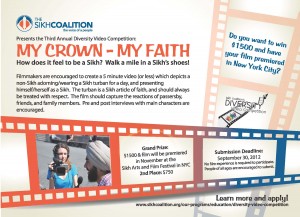 The use of social video sites by our community has seen an upward trend. Of course, many readers of this blog will instantly recognize individuals that have emerged in the last two to three years using YouTube and other social media sites – Mandeep Sethi, Humble the Poet, JusReign, and IISuperwomanII are but a few of the commonly recognized names from North America alone.
The use of social video sites by our community has seen an upward trend. Of course, many readers of this blog will instantly recognize individuals that have emerged in the last two to three years using YouTube and other social media sites – Mandeep Sethi, Humble the Poet, JusReign, and IISuperwomanII are but a few of the commonly recognized names from North America alone.
As it becomes more accessible, we are also seeing the emergence of more grassroots-level use of social video. This medium has allowed Sikhs, and particularly Sikh youth, to express themselves to an unprecedented audience size, and there are several organizations encouraging Sikhs to make use of this platform. For example, SikhNet has been running their Youth Online Film Festival since 2006, and the Sikh Coalition is also holding their third annual Diversity Video Competition for its third consecutive year.
Recently, Manbeena Kaur, the Sikh Coalition’s Education Director, was good enough to answer some questions about the use of social video for the purposes of Sikh education and awareness.
 During this past week following the tragic events in Wisconsin, our community has changed substantially. We have grown as a people and identified even more with Sikhi, standing up in a time of crisis, and responding in a positive and effective way, battling apathy with activism and suffering with solidarity.
During this past week following the tragic events in Wisconsin, our community has changed substantially. We have grown as a people and identified even more with Sikhi, standing up in a time of crisis, and responding in a positive and effective way, battling apathy with activism and suffering with solidarity.
SALDEF’s SikhLEAD Leadership Development Program will ensure that our youth remain engaged with the issues that continue to affect our community today and will provide them with the tools they need to enact real change. Although it may be a dark time for many of us, it is now more than ever that we need leaders and young activists leading the struggle against oppression. It is now more than ever that we need the younger generation to step up to the podium and speak out and act against injustice. It’s not enough to feel for our Sikh brothers and sisters anymore. The time is now for the youth to rise up and become leaders, especially in the wake of the Wisconsin shooting tragedy.
The Leadership Development Program brings together approximately 15 young Sikh American leaders from across the country to participate in six days of training spread over Columbus Day and Memorial Day weekends. Attendees will participate in a series of workshops aimed to challenge, inspire and support a group of intelligent and motivated Sikh leaders. The purpose of the program is to empower the Sikh American youth to be confident, aware and resourceful individuals, equipped with all the tools they need to fulfill both their personal potential but also that of the Sikh American community. For more details please visit www.sikhlead.org.
Let us take on the Guru’s seva together and become the pioneers of our own future, a future that has no place for events such as the Wisconsin shootings. The deadline to apply for the SikhLEAD LDP has been extended until August 19, 2012 at 11:59 EST.
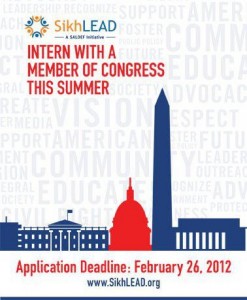 The Sikh American Legal Defense and Education Fund (SALDEF) has announced the application for the 2012 SikhLEAD Internship Program. The objective of SikhLEAD is to inspire, train, and support motivated and enterprising young Sikh American leaders as they prepare for a lifetime of community engagement and community leadership.
The Sikh American Legal Defense and Education Fund (SALDEF) has announced the application for the 2012 SikhLEAD Internship Program. The objective of SikhLEAD is to inspire, train, and support motivated and enterprising young Sikh American leaders as they prepare for a lifetime of community engagement and community leadership.
The internship program is aims to put Sikh American college and graduate students, as well as recent grad, in competitive internship in the White House, on Capitol Hill and government agencies. Through this program, students will be afforded first-hand perspective into the functioning of the federal government, as a way of providing experience-based training to individuals interested in civic engagement and government affairs.
Through the experience of interning in a congressional office, interns will:
- explore a potential career track
- create a network of professional and personal contacts
- develop real-world skills
- build confidence and professional work habits
The application deadline for summer 2012 internships is THIS SUNDAY, Feb 26th, 2012!
Visit www.sikhlead.org for more details and to apply. Spread the word and tell your friends about this exciting opportunity.
Let me first take the opportunity to thank the bloggers of TLH for welcoming me to this blog. A few might recognize me from americanturban.com, and I’m excited about the opportunity to engage with the audience on this blog in discussing many of the issues we face as a community, and particularly in the United States.
Most of my early education in Sikh history came from comic books, namely those published by Amar Chitra Katha, based in India. My father purchased every title related to Sikhism that was released by this company — covering the stories of the Sikh Gurus to those of Sikh legends and heroes — and I loved reading and re-reading these comic books until I knew the stories by heart.
It was a great introduction to Sikhism that captured my imagination. As I got older, I moved on from these comics to literary works on Sikh history that filled my growing mind with more knowledge and detail.
I started reading those comic books almost 30 years ago (I’m astounded as I write that number), and I’ve recently come across a new effort to bring such Sikh stories to today’s young audiences.
Gyan Khand Media has recently begun producing a new set of Sikh-based comic books. While now based in India, author Daljeet Singh Sidhu saw the opportunity for such a comic book after living in the west:
When Daljeet Singh Sidhu wanted to introduce his three-year-old son to Sikh heroes and history, he was not at a loss of words. But what he did not have, was a story that his boy could see, feel and later read. That’s when it struck Sidhu; that Sikh history has many heroes, but no graphics. So after 12 years in the US, he packed his bags and moved back to India to chronicle Sikh history, its great gurus and warriors and present them in the comics format. That’s how www.sikhcomics.com, a Sikh comics project, was born.
Gyan Khand Media has currently published three titles covering the stories of Baba Deep Singh, Guru Tegh Bahadur, and the Battle of Saragarhi. Many more are planned, and I had the opportunity to download and read the first two titles using Amazon’s Kindle app on my mobile device.
Here on TLH, we look forward to sharing stories about young Sikhs pursuing their passion.
YouTube, Lenovo, and Space Adventures are running a competition to find an amazing space experiment and 16-year-old Pranav Singh is one of the finalists! If he wins, his experiment will be carried out on the International Space Station and streamed live from space on YouTube.
You can view Pranav’s video below and learn about his experiment here. Don’t forget to VOTE! You can vote each day until January 24th. Pranav is a finalist and has a good chance to have his experiment picked! Remember, he is only 16-years old!
As Sundari blogged about a few days ago, we just had an exciting weekend of Sikh youth art and activism in the NY/NJ area. I was lucky enough to sit in on the Sikh Coalition’s “Inquilab: Raising Our Voices” hip hop workshop for a few hours on Saturday and then ride the bus to New Jersey with the youth to attend Lahir 2011: Move the Movement.
I managed to get some video footage of both events, so I will keep my own words to a minimum. Today I am posting a brief montage from the Inquilab workshop, and on Wednesday I’ll post some highlights from Lahir.
I walked into the workshop on Saturday in the basement of South Asian Youth Action in Elmhurst, Queens while the group was in the midst of a writing activity. Many of the young people of diverse backgrounds (mostly South Asian and many Sikh) ended up putting their newly honed writing skills to the stage — a pretty large stage — at Lahir that night. Their pieces were honest, real, accessible and courageous. I was truly inspired. And found myself wondering what my teenage years would have been like had something like this (both the workshop at Lahir) had existed.

When I met Sonny, I felt that his story demanded to be told. I was moved by his willingness to share difficult stories about how racism, xenophobia, and islamophobia impact him in a very daily and intimate ways. But more importantly, I was inspired by how he had turned this hardship into a motivation to fight for social justice for all people. I was welcomed with incredible warmth, and inspired by the Sikh traditions seeing the divine in all people, and fighting for equality. – Christina Antonakos-Wallace, Producer and Director of Article of Faith
To continue a discussion about bullying and bias-based harassment that seems to be appearing both here on The Langar Hall and also within langar halls across the nation, we wanted to take the time to highlight an inspiring documentary which discusses this very issue. Article of Faith is a short film, directed and produced by Christina Antonakos-Wallace, portraying one Sikh activist, Sonny Singh, who organizes New York City Sikh youth to combat harassment in their schools. Sonny shares his own, very personal experience with bullying recognizing how incredibly important it is for us to openly dialogue about these issues, so that other children who are experience similar challenges do not feel like they are alone.
Do you know how to tie a patka? The following video, an original creation by Keerat Kaur, was produced by Saffron Press in an effort to educate about the Sikh identity – allowing educators (and curious children) to learn how to tie a patka/dastaar and see what actually lies beneath the piece of cloth that covers a lion’s mane. As one blogger writes,
The video [reminds] me of a vague recollection I had of sitting in a room while two teachers were trying to figure out how to re-tie my patka on my head. I remember trying to explain how the patka was supposed to be tied, but the teachers couldn’t figure it out. I also recall how vulnerable I felt when, to attempt to re-tie it, they removed my patka and my hair was exposed.
Another blogger has similar memories of his childhood,
For most of my childhood, I was the only Sikh kid in school that had long hair. Never mind that the other kids didn’t know nor appreciate my Sikh identity, even my teachers were clueless about my faith.




